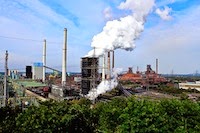- Contact Us
- Call Us
- Menu

Steam is used in many industrial processes today. It is used in the production of our food, textiles, chemicals, power generation and many other manufacturing systems. Steam is a major energy source for industry because it is cheap to create and easily transported through pipes. It can be used to provides energy for process heating, or it can provide energy to mechanical drives.
Steam uses energy in form of heat, which can be converted into other forms of energy. For example, in a power plant, steam is a medium that converts heat energy into mechanical energy (pressure that spins a turbine) and that mechanical energy is then converted into another useful form of energy – electricity.
Steam is produced by heating water. When water is heated in a vessel, its volume increases slightly. The water’s temperature increases as heat is added until it reaches its boiling point – 212 deg F. (100 deg. C) at atmospheric pressure. The boiling temperature of water varies with it’s pressure. As pressure increases, so does boiling point. The heat added to the water that only raises the temperature, but does not introduce any moisture or increase pressure is referred to as “sensible heat“. When water reaches boiling point, its temperature does not increase – even with additional heat. At boiling, water starts changing its “phase” from liquid phase to gaseous phase, turning into steam. The temperature of the water will remain constant until all water is converted into steam. Initially when steam formation begins, the steam contains some water particles – this called wet steam.
Dry steam is created when additional heat is added, and all the water is converted into steam leaving no water particles. The term dry, saturated steam means that all water is converted into steam, with no water particles present. The heat required to change from the liquid phase to the gas phase is called the latent heat of vaporization.
Superheated steam is created when additional heat is added to dry saturated steam, increasing the temperature of steam. Superheated steam is used mostly in power plants and other industries where heat energy is converted into mechanical energy.